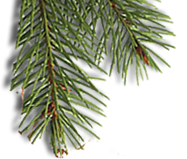|
|
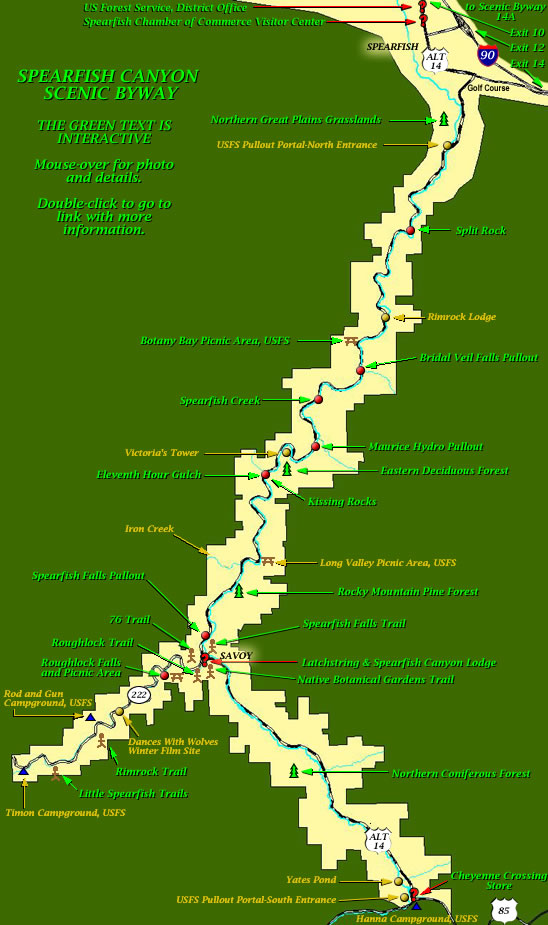
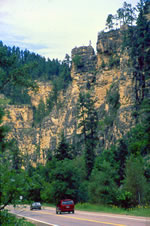 |
| Botany
Bay Picnic Area, USFS: The
narrow and winding Byway passes through a row of impressive rocky
spires to the east and massive vertical high-walls to the west.
Do not stray too far from the picnic area as poison Ivy and Oak
are in the vicinity. Help control litter to maintain the aesthetics
of the canyon, and for the safety of the wildlife. |
 |
| Cheyenne
Crossing: Originally
named Spearfish Crossing, this location is the south end of the
Byway at Highway 85. It is the original point where the old Deadwood-Cheyenne
Stage Line crossed Spearfish Creek. The quaint little country store
and restaurant provides traveler information, directions, meals,
fuel, and souvenirs. |
 |
| Little
Spearfish Trail: This 5.9-mile trail begins at the Timon Campground
and meanders through the dense forest exposing views of the limestone
cliffs and the ambiance of Little Spearfish Creek. It is maintained
for hikers, horseback, and mountain biking. |
 |
| Northern
Coniferous Forest: Another
of the 4 biomes – plant communities- that makes the Canyon the “most
marvelous canyon in the West” according to renowned architect,
Frank Lloyd Wright. The predominant species is White Spruce with
branches frequently laced with silvery green lichen called "old
man's beard". |
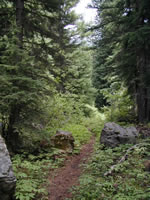 |
| Rimrock
Trails: Both trails meander through a serene setting of Ponderosa
pine stands, quaking aspen, and paper birch, and are maintained
for hikers, horseback, and mountain biking. The trailhead for
the 3.5-mile Lower Loop is located at the Rod and Gun Campground,
and the 4.5-mile Upper Loop is located at the Timon Campground. |
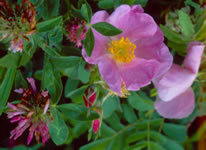 |
| Native
Botanical Garden: The
colorful and interpretive gardens surround the Latchstring restaurant
and present an interesting and informative display of 145 species
of native vegetation. The theme of the garden is to encourage
water conservancy and water quality. The 1996 project was constructed
by volunteers of the US AmeriCorp program. |
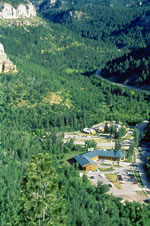 |
| Latchstring & Spearfish
Canyon Lodge: Savoy hosts
the popular Latchstring restaurant and Spearfish Canyon Lodge
and Conference Center where visitors can get information, directions,
meals, a restroom break, or a tranquil nights lodging. The 54-room
lodge is open year-round, and offers snowmobile and bicycle rentals,
and fishing licenses. |
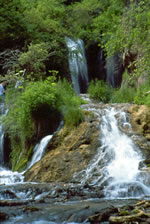 |
| Roughlock
Falls and Picnic Area: A
mile west from the Scenic Byway at Savoy on FDR 222 is located
a serene picnic area and flowing waters of little Spearfish Creek
just as it begins cascading over Roughlock Falls. Formal trails
provide observations areas at the top of the Falls and a panoramic
view from the bottom. Visitors are encouraged to stay on the
paths to avoid accelerating erosion. |
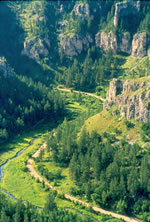 |
| Roughlock
Trail: This “handicapped-accessible”,
mile long trail begins at the end of the Lodge parking lot, and
meanders through a lush wet meadow paralleling Little Spearfish
Creek to Roughlock Falls and a picnic area. The Falls has receded
about 300 feet in the past 100 years, and visitors are asked
not to divert off the trail’s pathway to prevent further erosion. |
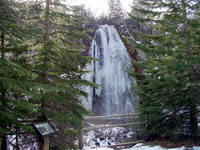 |
| Spearfish
Falls Trail: This 35-minute
trail takes you on a journey to the bottom of the canyon floor
that is ecological pristine and provides an awesome view of Spearfish
Falls joining Spearfish Creek. The trail has two ratings; “easy” from
Latchstring to the Falls; and “difficult” should you choose not
to backtrack, but continue on the steep natural tread back to
the Latchstring. |
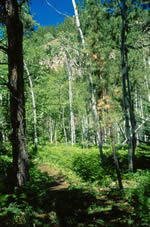 |
"76
Trail: This sensational trail
takes you on a steep incline to the top of the rim at Buzzard’s
Roost for a spectacular panoramic view of the canyon. The trailhead
is across from the Lodge, is rated “difficult”, and takes about
one-hour, roundtrip. It is part of the historic ’76 Trail that
miners used to link the gold fields of Tinton to Lead/Deadwood. |
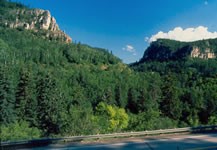 |
| Rocky
Moutain Pine Forest: Another
of the 4 biomes – plant communities- that makes the Canyon the “most
marvelous canyon in the West” according to renowned architect,
Frank Lloyd Wright. This biome is the most dominant biome of
the canyon, and Ponderosa Pine is found on the canyon rim and
encroaching into all other biomes in the deep gorge. |
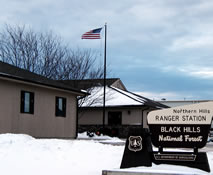 |
| US
Forest Service: The Northern Hills Ranger
office welcomes visitors and provides insightful information on trails
and habitat. It maintains interpretive portal pullouts at the north
and south entrances to the Canyon, and hosts a number of picnic areas
and campgrounds. |
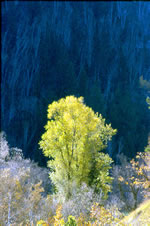 |
| Northern
Great Plains Grasslands: One
of 4 biomes – plant communities- that makes the Canyon the “most
marvelous canyon in the West” according to renowned architect,
Frank Lloyd Wright. Note the dominant prairie grasses, trees,
birds, and mammals as it converges with the Eastern Deciduous
Forest further up the canyon. |
 |
| Spearfish Chamber of Commerce Visitor Center: This
tourist organization welcomes walk-ins and hosts impressive interpretive
displays of Spearfish Canyon and other points of interest in the Black
Hills. Visitor information
will be supplied upon request. |
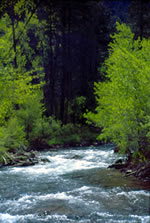 |
| Spearfish
Creek: One of the State’s few fresh water fishery that sustains
self-propagating Rainbow trout. Rainbow, Brook and Brown make
the canyon a popular fly fishing spot. At this point, the 65cfs –annual
average mean flow - is diverted through a 6-mile tunnel to
a hydro-electric generation plant in Spearfish Park, and then
released to the creek channel. |
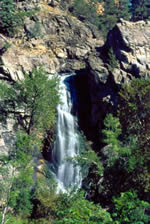 |
| Bridal
Veil Falls Pullout: A
small picturesque waterfall adjacent to the Byway across from
the pullout parking, its small cascade barely veils the rocks
that support its 60-foot descent. Though very active in the
spring snowmelt, it often reduces to a trickle by the late
dry summer months of August and September. |
 |
| to
Scenic Byway: Exit 10 off Interstate 90 heralds the beginning
of the unique Spearfish Canyon Scenic Byway and provides excellent
access for traveler information at the USFS District Office
and the Spearfish Chamber. Meander through the downtown business
district and turn south at the Spearfish Canyon Golf Course
where “things
begin to happen”. |
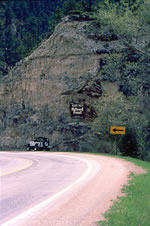 |
| Split
Rock: Carved through
a massive domed rock to accommodate the railroad in the late
1800’s, the Byway now passes between this porous limestones outcropping
of the massive Madison Aquifer. In this area, over a third
of the creek’s stream flow would be lost to the underground passages. |
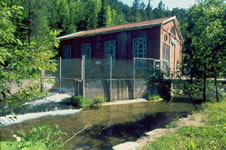 |
| Maurice
Hyrdo Pullout:
This
historic building, built in 1917, once housed the Homestake
Hydro Plant #2 that diverted water in a 5-mile flume from
Savoy . |
 |
| Eastern
Deciduous Forest: Another
of the 4 biomes – plant communities- that makes the Canyon the “most
marvelous canyon in the West” according to renowned architect,
Frank Lloyd Wright. Note the dominant aspen and birch trees,
and willow shrubs, and associated birds, and mammals as it converges
with the Rocky Mountain Pine Forest influence. |
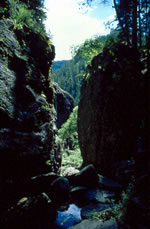 |
| Eleventh
Hour Gulch: A
narrow 20-foot passage marks the convergence of 11 th Hour Gulch
to the canyon. This popular rock feature, said to have gotten
its name from the first appearance of sunlight at 11am, is directly
across the Byway from Kissing Rocks. It is easy to miss, so drive
slowly near mile-marker 20. |
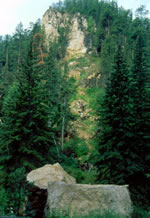 |
| Kissing
Rocks: Two large boulders broke loose from the side
walls and came crashing down to the creek so swiftly that two deer
were caught in the slide. It is symbolic of the ever-relenting erosion
and contouring of the limestone canyon. |
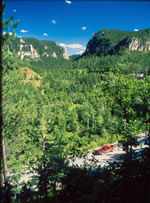 |
| Spearfish
Falls Pullout: From here,
you can see Spearfish Falls between the trees below Latchstring.
The falls was restored to premiere-falls status in 2003 after
nearly 86-years of water diversion through flumes to the Maurice
Hydro Plant. Visitors wishing to visit the falls, should pullout
at the Latchstring parking lot, and take the 35-minute Spearfish
Falls Trail. |
|
| |
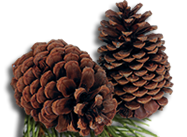 |
|


